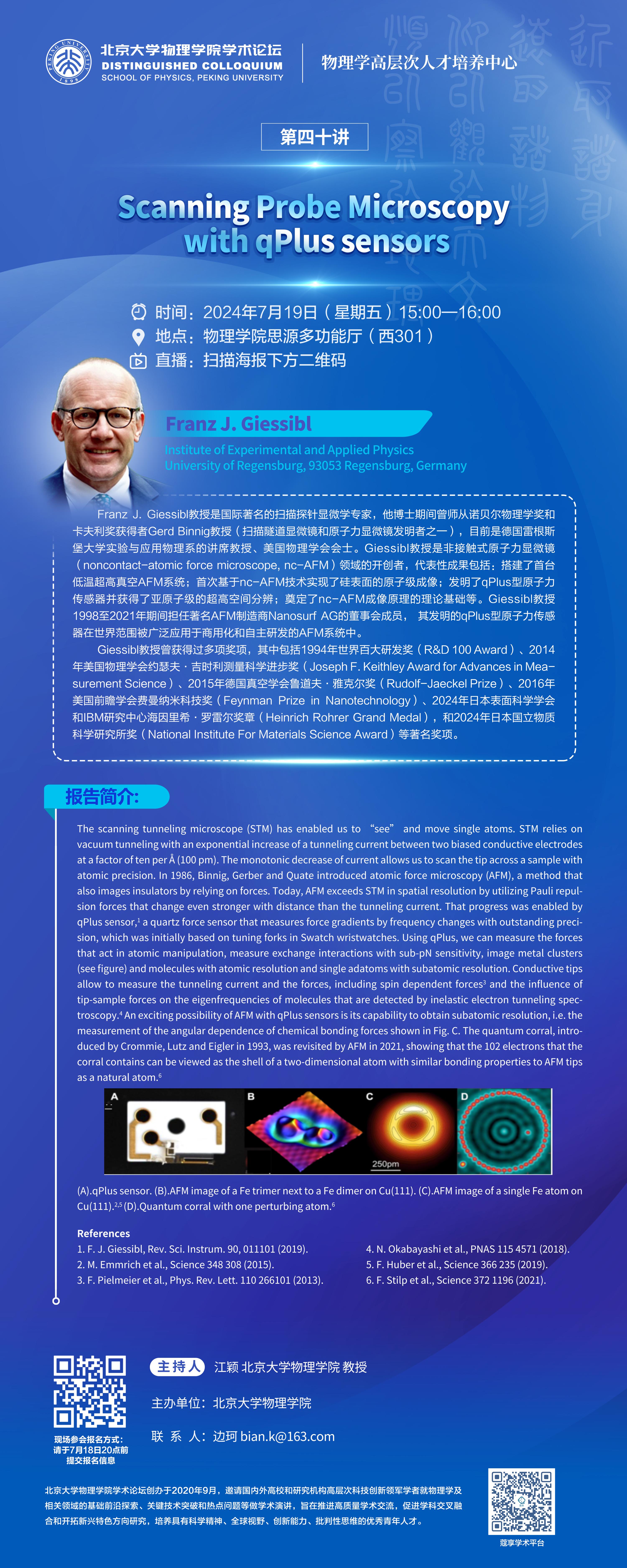报告摘要:
The scanning tunneling microscope (STM) has enabled us to “see” and move single atoms. STM relies on vacuum tunneling with an exponential increase of a tunneling current between two biased conductive electrodes at a factor of ten per Å (100 pm). The monotonic decrease of current allows us to scan the tip across a sample with atomic precision. In 1986, Binnig, Gerber and Quate introduced atomic force microscopy (AFM), a method that also images insulators by relying on forces. Today, AFM exceeds STM in spatial resolution by utilizing Pauli repulsion forces that change even stronger with distance than the tunneling current. That progress was enabled by qPlus sensor,1a quartz force sensor that measures force gradients by frequency changes with outstanding precision, which was initially based on tuning forks in Swatch wristwatches. Using qPlus, we can measure the forces that act in atomic manipulation, measure exchange interactions with sub-pN sensitivity, image metal clusters (see figure) and molecules with atomic resolution and single adatoms with subatomic resolution.Conductive tips allow to measure the tunneling current and the forces, including spin dependent forces3and the influence of tip-sample forces on the eigenfrequencies of molecules that are detected by inelastic electron tunneling spectroscopy.4An exciting possibility of AFM with qPlus sensors is its capability to obtain subatomic resolution, i.e. the measurement of the angular dependence of chemical bonding forces shown in Fig. C. The quantum corral, introduced by Crommie, Lutz and Eigler in 1993, was revisited by AFM in 2021, showing that the 102 electrons that the corral contains can be viewed as the shell of a two-dimensional atom with similar bonding properties to AFM tips as a natural atom.6

(A).qPlus sensor.(B).AFM image of a Fe trimer next to a Fe dimer on Cu(111).(C).AFM image of a single Fe atom on Cu(111).2,5(D).Quantum corral with one perturbing atom.6
References
1. F. J. Giessibl,Rev. Sci. Instrum.90, 011101 (2019).
2. M. Emmrich et al.,Science348308 (2015).
3. F. Pielmeier et al.,Phys. Rev. Lett.110266101 (2013).
4. N. Okabayashi et al.,PNAS1154571 (2018).
5. F. Huber et al.,Science366235 (2019).
6. F. Stilp et al.,Science3721196 (2021).
报告人简介:
Franz J. Giessibl教授是国际著名的扫描探针显微学专家,他博士期间曾师从诺贝尔物理学奖和卡夫利奖获得者Gerd Binnig教授(扫描隧道显微镜和原子力显微镜发明者之一),目前是德国雷根斯堡大学实验与应用物理系的讲席教授、美国物理学会会士。Giessibl教授是非接触式原子力显微镜(noncontact-atomic force microscope, nc-AFM)领域的开创者,代表性成果包括:搭建了首台低温超高真空AFM系统;首次基于nc-AFM技术实现了硅表面的原子级成像;发明了qPlus型原子力传感器并获得了亚原子级的超高空间分辨;奠定了nc-AFM成像原理的理论基础等。Giessibl教授1998至2021年期间担任著名AFM制造商Nanosurf AG的董事会成员,其发明的qPlus型原子力传感器在世界范围被广泛应用于商用化和自主研发的AFM系统中。
Giessibl教授曾获得过多项奖项,其中包括1994年世界百大研发奖(R&D 100 Award)、2014年美国物理学会约瑟夫·吉时利测量科学进步奖(Joseph F. Keithley Award for Advances in Measurement Science)、2015年德国真空学会鲁道夫·雅克尔奖(Rudolf-Jaeckel Prize)、2016年美国前瞻学会费曼纳米科技奖(Feynman Prize in Nanotechnology)、2024年日本表面科学学会和IBM研究中心海因里希·罗雷尔奖章(Heinrich Rohrer Grand Medal),和2024年日本国立物质科学研究所奖(National Institute For Materials Science Award)等著名奖项。
现场参会报名方式:请于7月18日20点前提交报名信息

9159金沙申请大厅学术论坛:创办于2020年9月,邀请国内外高校和研究机构高层次科技创新领军学者就物理学及相关领域的基础前沿探索、关键技术突破和热点问题等做学术演讲,旨在推进高质量学术交流,促进学科交叉融合和开拓新兴特色方向研究,培养具有科学精神、全球视野、创新能力、批判性思维的优秀青年人才。
主办单位
9159金沙申请大厅
